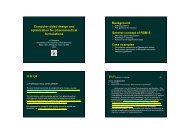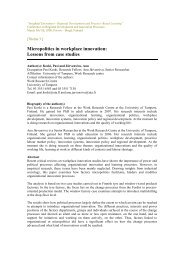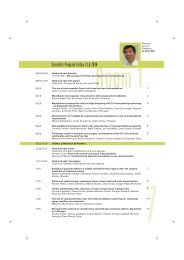Enhancing employees' innovation activity through motivational factors
Enhancing employees' innovation activity through motivational factors
Enhancing employees' innovation activity through motivational factors
Create successful ePaper yourself
Turn your PDF publications into a flip-book with our unique Google optimized e-Paper software.
“Insightful Encounters - Regional Development and Practice–Based Learning”<br />
Conference on Regional Development and Innovation Processes<br />
March 5th-7th, 2008, Porvoo - Borgå, Finland<br />
Introduction<br />
Innovativeness has been considered one of the survival elements in the modern business<br />
environment. In the closed <strong>innovation</strong> environments <strong>innovation</strong>s and inventions have been<br />
generated inside a company by their engineers and researchers. When competition has become<br />
global, it has forced companies to open up their <strong>innovation</strong> activities. Knowledge diffusion has<br />
accelerated enormously <strong>through</strong> the revolution of the Internet and during the last decade<br />
knowledge and the skills to use it has become the most important resource for companies. Open<br />
<strong>innovation</strong> philosophy (Chesbrough 2003; Dodgson et al. 2006) stress that the innovative ideas<br />
can come also from outside the organisation.<br />
The changing environment requires every organisation skills to observe proactively inside and<br />
outside of organisation to spot the useful signals. As for creating conditions for effective<br />
<strong>innovation</strong>, Bessant and Tidd (2007) come up with three critical phases. Firstly, a company needs<br />
to have effective ways of searching the signals to generate <strong>innovation</strong> possibilities. Secondly, the<br />
selecting of the good ideas with which to proceed needs to be strategic choices. Thirdly, the<br />
implementation of ideas should be realised with balance of creativity and control.<br />
The focus in this paper is finding ways to benefit from the proactive external linkages. One group<br />
that has a lot of proactive linkages outside organisation is the salespeople. They constantly hear<br />
the voice and opinions of the very important persons for the organisation: from the customers.<br />
Traditionally the salespeople work has been individual performance and the customer knowledge<br />
has been an asset of power in competition between salespeople. So the key question here is: How<br />
to motivate the salespeople to share the customer knowledge? This paper aims to create<br />
knowledge on how to motivate the salespeople to share their customer knowledge and discusses<br />
the influence of executives on motivation.<br />
How to accomplish motivated employees?<br />
To successfully conduct change process in organisation, good leaders will try to affect to<br />
employees’ motivation instead of giving orders. Motivation determinates what people really do<br />
(Amabile 1998). Jobs can be assigned and they will be done adequately, but for employees to do<br />
more than business as usual they need to feel motivated. Motivation helps individuals to develop,<br />
as do organisational <strong>factors</strong> like management support, resources, work group features, reward<br />
systems, adequate evaluation process, challenge and freedom (van Dijk & van den Ende 2002;<br />
Amabile 1998).<br />
Why motivation is still one of the most important <strong>factors</strong> while studying employees and<br />
management in the organisation? The answer would be that in order to survive in nowadays<br />
business, the motivation is the major issue to taken care of. The motivation is highly challenging<br />
and continuously changing area, since <strong>motivational</strong> <strong>factors</strong> depends on lot of different matters for<br />
example age, position, task, manager’s support and behavior, reward systems and so on.<br />
There exists numerous ways to define the motivation concept. Even though motivation<br />
approaches have been developed over the years, in most of them is possible to recognise features<br />
from history, for example from Maslow's need-hierarchy theory or Herzberg's two-factor theory.<br />
According to Kreitner (1995) motivation is the psychological process that gives behavior purpose<br />
and direction. Buford et al. (1995) suggest that motivation is predisposition to behave in a<br />
purposive manner to achieve specific, unmet needs. Higgins (1994) and Bedeian (1993) state that








